1. Introduction
With the rapid development of in-vehicle entertainment, audio systems, and intelligent driving technologies, the Automotive Audio Bus (A2B) system has become a critical technology for modern automotive audio and data transmission. As a high-performance, low-latency audio and control signal transmission technology, the A2B bus supports a single-master, multi-slave architecture, simplifying system wiring and enhancing transmission stability. It is widely used in in-vehicle audio systems, Active Noise Cancellation (ANC), voice interaction, and smart cockpit systems. However, in practical applications, A2B signal transmission quality is susceptible to electromagnetic interference, line attenuation, connector quality, and vehicle operating environments. Therefore, accurately testing A2B signals to evaluate their stability and transmission performance under complex conditions is a significant industry challenge.
Currently, vehicle A2B signal testing is primarily conducted in laboratory environments using bench or static tests to analyze A2B audio signals and data transmission. While this method can evaluate system performance under controlled conditions, it fails to simulate complex factors such as vibration, electromagnetic interference, and temperature/humidity fluctuations during actual driving. Laboratory testing lacks real-world environmental data, making it difficult to comprehensively reflect the true operational state of the A2B system. This often leads to issues like signal attenuation, data loss, or synchronization errors after vehicle integration. Consequently, relying solely on laboratory testing cannot meet the verification needs of A2B systems under normal driving conditions.
To address this, we have developed a vehicle A2B signal testing solution based on a high-performance data acquisition (DAQ) system. This solution supports A2B signal testing during vehicle operation, enabling real-time monitoring of transmission quality, data synchronization, and environmental impacts. Combined with multi-dimensional data analysis, it more accurately evaluates the stability and transmission performance of the A2B system under real-world conditions. The accompanying analysis software performs signal evaluation, spectrum analysis, and anomaly detection, improving testing efficiency. This solution is suitable not only for A2B audio signal testing but also for evaluating the data transmission characteristics of the A2B bus, providing support for system optimization, fault diagnosis, and mass-production validation.
2. Introduction to Vehicle A2B Equipment
In-vehicle audio systems are essential components of modern automobiles, directly impacting user auditory experiences and intelligent interaction capabilities. As automotive electronics advance, traditional analog audio transmission methods can no longer meet demands for high fidelity, low latency, anti-interference, and multi-channel transmission. Thus, A2B (Automotive Audio Bus) technology has emerged as the mainstream solution for in-vehicle audio transmission.
Developed by Analog Devices, A2B is a high-bandwidth, low-latency digital audio bus technology. It adopts a single-master, multi-slave architecture, transmitting I²S/TDM audio data, I²C control signals, clock, and power over a single unshielded twisted pair (UTP). Compared to traditional interfaces like I²S and TDM, A2B simplifies in-vehicle audio system wiring while offering stronger electromagnetic interference resistance, significantly reducing system cost and power consumption. As a result, A2B is widely used in in-vehicle audio, Active Noise Cancellation (ANC), voice recognition, e-Call, echo cancellation, and vehicle communication systems.
In this testing solution, vehicle A2B equipment primarily refers to the A2B audio module responsible for audio signal transmission. This module typically connects to components such as the head unit, amplifier, microphone array (MIC Array), and T-BOX. Due to its cost-effective and efficient multi-channel audio transmission and synchronization capabilities, A2B has become the core communication method for modern intelligent vehicle audio systems. Testing A2B signals comprehensively evaluates their transmission quality, data synchronization, and anti-interference capabilities, ensuring stability and audio quality under complex operating conditions.
3. Specific Testing Solution
3.1 Test System
The test system uses a customized PXIe chassis with a compact structure that can be installed under the front passenger seat, providing high-performance data acquisition and processing without disrupting cabin layout. During testing, vehicle A2B audio signals are first routed to the A2B acquisition card for precise multi-node signal acquisition and synchronized analysis. Simultaneously, the rain sensor connects to the controller's USB port via a UART-USB converter, enabling compatibility conversion for accurate environmental data parsing. The test system schematic is shown below:
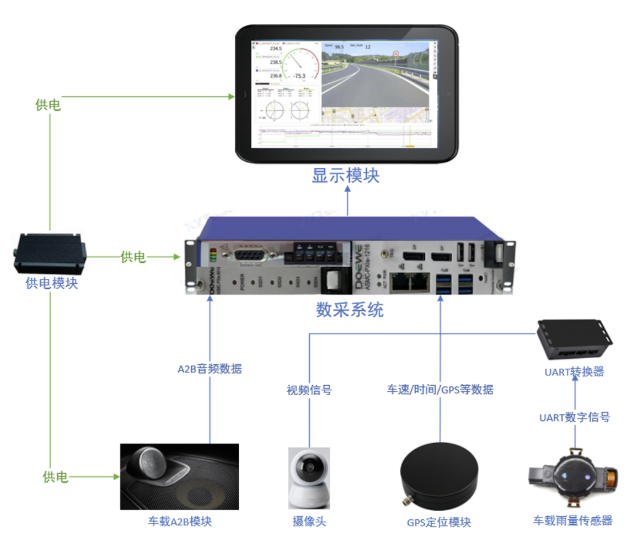
Figure 1 Test System Schematic
Additionally, the system includes a GPS module and dual cameras to record vehicle speed, location, acceleration data, and interior/exterior environmental conditions. One camera is installed inside the cabin to capture cabin conditions and potential audio interference factors, while another is mounted at the front to record external environmental changes during driving, providing comprehensive references for data analysis. Real-time monitoring and analysis are performed via a touchscreen display connected to the DAQ system, allowing testers to observe signal quality, environmental impacts, and test progress.
All devices are powered by a power module supplied by the vehicle voltage converter, ensuring long-term stable operation. Throughout the testing process, the DAQ system not only efficiently acquires vehicle A2B signals but also provides reliable support for real-world driving analysis through synchronized environmental data recording.
3.2 ASMC Analysis Software
The ASMC analysis software is the core of this solution, responsible for real-time monitoring, processing, and visualization of acquired data. Developed in-house and optimized for vehicle A2B signal testing, it delivers efficient data analysis during driving. The software supports real-time monitoring and data recording, enabling testers to view A2B audio signals, GPS data, environmental sensor data, and camera feeds while storing them in real time. It also features anomaly detection and alerting, automatically identifying signal abnormalities based on speed and location data to prompt timely adjustments.
For data analysis, ASMC software supports multi-dimensional data synchronization and visualization. It evaluates A2B signal transmission stability, synchronization accuracy, and environmental impacts through spectrum analysis, signal comparison, and waveform playback. User-friendly functions like one-click data tagging and pausing enhance operational efficiency. The software also allows data trimming and filtering based on speed, time, or GPS paths, enabling automated export to streamline subsequent analysis.
Deep integration with the PXIe DAQ system allows this solution to deliver high-precision, efficient data acquisition and analysis in real driving environments, providing robust support for A2B system optimization, fault diagnosis, and performance evaluation. The software interface schematic is shown below:
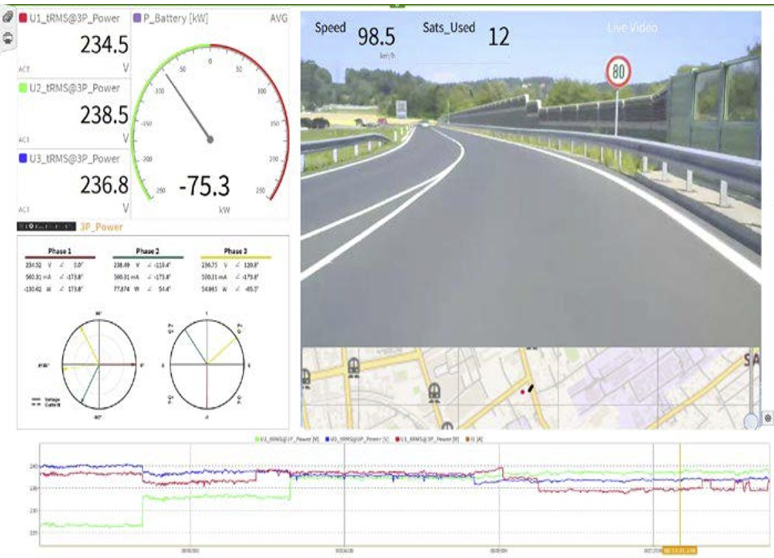
Figure 2 Software Interface Schematic
3.3 Testing Methodology
This solution uses the DAQ system for real-time acquisition and analysis of A2B signals and external environmental data. During driving, the A2B acquisition card captures vehicle A2B audio signals, performing synchronized recording and processing of multi-node audio data. Simultaneously, the controller receives real-time rain sensor data and logs vehicle speed, location, and acceleration via the GPS module. Interior and front-facing cameras capture environmental video data, providing references for analyzing driving conditions' impact on A2B signals.
All acquired data is managed and analyzed by the ASMC software installed on the controller. Developed in-house, this software features highly integrated data processing and visualization capabilities, enabling real-time monitoring of A2B signal transmission quality, environmental impacts, and anomalies. It supports data storage and playback for subsequent analysis and comparison. Through data synchronization, signal analysis, and anomaly detection, the system accurately evaluates the stability and reliability of A2B signals in real driving environments.
This methodology comprehensively assesses the A2B system's transmission quality, synchronization accuracy, and environmental adaptability under complex conditions, delivering powerful data support for system optimization, fault diagnosis, and application validation.
3.4 Solution Analysis
This solution comprehensively evaluates the transmission quality, synchronization accuracy, and environmental adaptability of vehicle A2B signals to verify the performance stability of A2B audio devices under real-world conditions. Traditional vehicle A2B testing is limited to laboratory environments and fails to fully reflect impacts from signal attenuation, electromagnetic interference, environmental noise, and system load variations during driving. This solution's advantage lies in its ability to perform multi-dimensional monitoring and analysis of A2B signal transmission characteristics and quality under actual driving conditions.
The test system adopts a highly integrated PXIe architecture, combining the A2B acquisition card, controller, storage module, and power supply into a single unit, significantly enhancing stability and reliability. For data acquisition, the system supports synchronized acquisition of up to 10 A2B audio nodes and 32 audio channels, accurately capturing signal transmission characteristics of multi-node systems to ensure high precision and data integrity. Equipped with a 16TB NVMe storage card offering excesses 6GB/s data transfer capability, it meets long-duration, high-speed data acquisition needs, providing ample storage for subsequent analysis.
Beyond A2B signal acquisition and storage, this solution features multi-dimensional data correlation analysis. The system synchronously acquires vehicle speed, GPS trajectories, rainfall data, and interior/exterior video, automatically matching and correlating these datasets via ASMC software. By comparing A2B signal characteristics under different conditions, it identifies impacts from signal attenuation, loss, synchronization errors, and external interference. The analysis software also supports signal trimming, waveform comparison, and anomaly detection, enabling rapid problem identification and data-driven optimization.
The core advantages of this solution are its high integration, high-precision data acquisition, and multi-dimensional data fusion analysis. By monitoring A2B signals in real-time during driving, it effectively bridges the limitations of traditional lab testing, providing reliable foundations for A2B system optimization, troubleshooting, and mass-production validation.
4. Core Test Equipment
This solution employs a high-performance DAQ system to ensure precise acquisition, storage, and analysis of A2B signals and environmental data. The system primarily consists of a PXIe storage card, PXIe controller, A2B acquisition card, and ASMC analysis software. Each component plays a critical role in ensuring data integrity, real-time performance, and efficient processing.
4.1 PXIe Storage Card
The PXIe storage card handles high-capacity data storage for long-duration, high-speed recording. Utilizing NVMe protocol, it offers high throughput and low latency within a compact PXIe chassis. Its host interface is PCI Express X8 GEN3, supporting up to 8GB/s data bandwidth to meet high-precision storage demands for A2B signals and environmental data. With sustained write speeds exceeding 6GB/s, it ensures data integrity and real-time acquisition. Compatible with Windows OS, it delivers efficient data access.
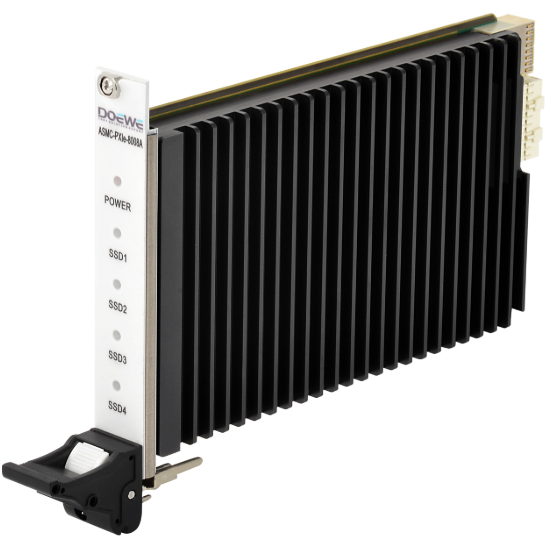
Figure 3 Storage Card
4.2 PXIe Controller
The PXIe controller serves as the central computing unit for data processing, synchronized analysis, and communication management. Equipped with a high-performance processor and multi-threading capabilities, it handles large-scale data processing and multi-tasking. Standard with high-capacity DDR4 RAM (expandable as needed) and SSD storage (scalable for long-duration recording), it features multiple USB ports and Gigabit Ethernet interfaces for data transfer and device expansion. Compliant with PXIe specifications, it operates stably under harsh automotive environments (high temperature/vibration), providing efficient and reliable computational support.
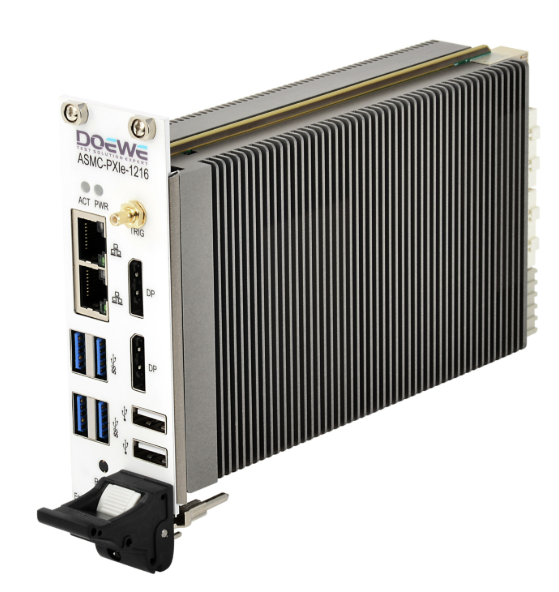
Figure 4 Controller
4.3 A2B Acquisition Card
The A2B acquisition card is the key module for high-precision acquisition and real-time processing of vehicle A2B signals. Designed as a PXIe module, it supports high-resolution, high-sampling-rate acquisition and synchronized multi-channel processing of multiple A2B nodes. Compliant with A2B bus master/slave testing standards, it precisely measures transmission quality, clock synchronization, and environmental interference impacts. Its high-precision acquisition capability ensures audio signal integrity and low-latency transmission for complex in-vehicle audio systems.
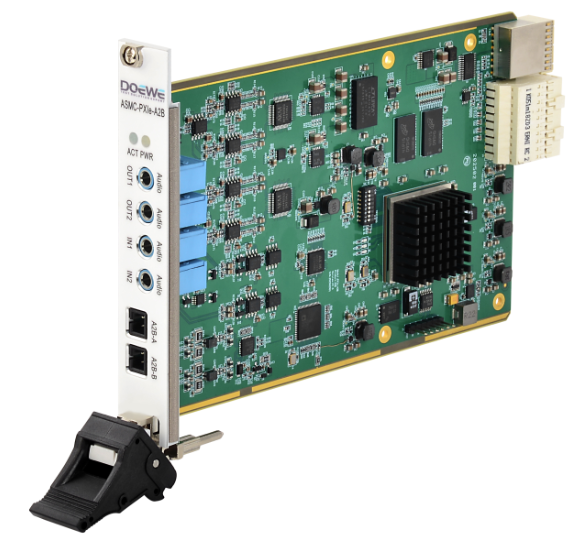
Figure 5 A2B Acquisition Card
5. Conclusion
The vehicle A2B signal testing solution based on the DAQ system, proposed by Doewe Technologies, enables precise monitoring and analysis of A2B signal transmission stability, synchronization accuracy, and environmental impacts during actual vehicle operation. This comprehensively evaluates the stability and reliability of in-vehicle A2B audio systems.
Implementing this solution overcomes the limitations of traditional laboratory testing, enabling in-depth study of A2B signal integrity, anti-interference capability, and transmission characteristics under dynamic driving conditions. It provides reliable data support for optimizing in-vehicle audio systems, enhancing performance, and enabling engineering applications, driving further advancement of A2B technology in intelligent vehicles.
Doewe Technologies is always committed to achieving innovative, unique, and reliable product solutions in the field of data acquisition. We deeply understand that these elements are the cornerstone for enterprises to establish themselves in market competition. For this reason, we derive innovative inspiration from customers' real application needs, rather than merely showcasing flashy product features. By continuously optimizing and enhancing data acquisition solutions, Doewe Technologies empowers partners to move towards an efficient and precise future. Welcome to choose Doewe Technologies and together embark on a new chapter in data acquisition. Contact Tel: +86-10-64327909.